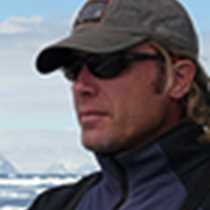Cascade Creek, Petersburg
Scenery and weather in Southeast Alaska can take on a homogeneous feel. Sitka alder, Sitka spruce, and Western hemlock dominate as large, conspicuous flora from the sea to middling heights. Rugged, rocky, snow-covered ramparts stretch towards the sky, but mist and low-slung clouds usually shroud their pinnacles and reveal only the green low bases from which they rise. Rain moves through this environment with the frequency of baseballs hurled from a pitching machine; it is virtually omnipresent and the lifeblood of the temperate rainforest. The stage this morning fell in line with predictability as we awoke already at anchor off the outlet of Cascade Creek. The sun did not shine and the winds blew light and fair. It was not raining, but the air was heavy with moisture – thick, cool, and lung cleansing.
The tide was high as we stepped ashore upon a thin strip of rocky beach perhaps a hundred meters down-beach from the pumping terminus of this narrow but lively watercourse. The trail, virtually all on a boardwalk constructed and maintained by the U.S. Forest Service, wound through a network of tangled tree roots and dense low shrubbery impressively blanketed by a rich green patina of mosses, lichens, and ferns. The creek roared with energy and showered us with mist at one well-positioned viewing platform. Twisting along the watercourse, continually fed by its headwater parent, Swan Lake, three miles farther up the gorge, the boardwalk was a pathway through a quintessential segment of the Southeast Alaskan biome.
Just before heaving the anchor, Dr. Fred Sharpe, a humpback whale researcher who principally focuses his studies on the Southeast Alaskan population, came aboard, via his own Zodiac, to expand our knowledge of Southeast Alaska’s most famous marine mammals. Implementing his studies with the latest in technological innovation, he and his support team have been able to forward the understanding of these aquatic denizens into rarified air, posing questions and searching for answers that just a decade ago would have seemed the realm of fanciful thinking. His diligent, and perhaps, even enlightened, hard work has borne fruit. He shared his latest findings in the form of a luminous presentation that augmented our own recent experiences, and left us all on the cutting edge of deeper comprehension and compassion.
Just after lunch, our vessel slowed, left Frederick Sound, turned towards the west, and entered the northern entrance to Wrangell Narrows. Inside the mouth a few homesteads quickly appeared. They were well spaced, mildly isolated from one another. Quickly the density of buildings increased. In short time, we were abreast of Petersburg. After some slow and deft maneuvering through the town’s principal harbor, the National Geographic Sea Lion was alongside in Alaska’s Little Norway.
Petersburg is a year-round community, which traces its origins to one man, the Norwegian Peter Buschmann. He had eyed the blue ice of LeConte Glacier, which lies across Frederick sound from present-day Petersburg, with capitalistic instinct. He decided the north end of Mitkof Island, with glacier ice available nearby, would be an ideal spot for a cannery. In 1897, construction began on the new site for Icy Straits Packing Co., for which Buschmann was manager. Thus a town was born. Its primary source of revenue continues to come from commercial fishing.
Today we comprised just a few of the approximately 40,000 tourists that visit Petersburg annually. Our choices for perusing the town and surrounding area were myriad. Many chose to brave floatplane adventures for a bird’s eye perspective. The town is small and easily transected by foot. However, the option to strike out by bicycle was an appealing option, as it obviously allows for a more rapid and extensive exploration. No matter the mode of transport, there were no more groups; no guided hikes en masse; just individually carved paths of personal discovery – often the best way to spend time in a new environment.
The final choice for those willing to eschew humanity and its constructs was a walk along a boardwalk through a patch of muskeg. Muskeg comprises as much as ten percent of Southeast Alaska. A community of acidic soil-tolerant plants, generally dominated by shore pines and sphagnum moss, muskeg appears as a banzai forest. Everything is dwarfed, stunted, or low-lying. Floral residents are best explored on hands and knees. This unusual terrestrial habitat was a new encounter on our sojourn, another piece of the Southeast Alaskan experience, expanding our perspective and broadening our understanding of the temperate rainforest.
Call +1.800.397.3348 or contact your travel advisor



